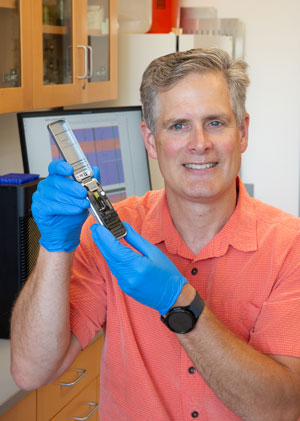

The Oxford Nanopore MinION sequencer sits on top of the desktop computer, while Dr. Scott Ferguson pulls up data on the monitor.


The Oxford Nanopore MinION sequencer sits on top of the desktop computer, while Dr. Scott Ferguson pulls up data on the monitor.
SUNY Fredonia students can undertake cutting-edge research using an Oxford Nanopore MinION sequencer -- an instrument that, incredibly, is no larger than a Snickers bar.
Genomic-scale DNA Sequencing projects that were previously only possible at major research centers such as Roswell Park Comprehensive Cancer Center are being integrated into the core biology curriculum at Fredonia.
The output of DNA sequencing technology has increased by orders of magnitude in the last 15 years, according to Department of Biology Associate Professor Scott Ferguson, who coordinates the Molecular Genetics program. “This technology has made it possible to sequence an entire human genome and identify disease causing variants in hours, rather than years,” he said.
“Like a thread passing through the eye of a needle, the new technology routes individual strands of DNA through nanoscale pores to determine their chemical makeup,” Dr. Ferguson explained.
It’s highly unusual to have this kind of technology available at a school our size, however it will continue to facilitate the tradition of providing authentic research experiences to students that are the hallmark of a Fredonia science degree.” - Dr. Scott Ferguson
Students will use the DNA sequencer in courses and labs taught by several Biology faculty beginning in the fall semester, expanding the capacity of those courses as well as collaborative research projects.
Students enrolled in Molecular Genetics, Biology, Medical Laboratory Science, and Biochemistry programs will gain experience with the DNA sequencer, Dr. Ferguson explained. “By integrating it into the curriculum, not just a select few research students, but all of these majors will get a chance to use it in the genetics lab that is part of their degree,” Ferguson said.
It’s fairly rare for undergraduate universities to have their own Nanopore DNA Sequencer, according to Ferguson. They are most often found at major research schools rather than primarily undergraduate institutions like Fredonia.

“It’s highly unusual to have this kind of technology available at a school our size,” he said, “however it will continue to facilitate the tradition of providing authentic research experiences to students that are the hallmark of a Fredonia science degree,” he said.
Ferguson will use the sequencer in his sophomore genetics course this fall, so nearly every student in the Department of Biology will be exposed to this cutting-edge technology to identify new mutations that they generate using the gene editing technique known as CRISPR.
It will also be deployed in his advanced molecular genetics lab course for more sophisticated research in collaboration with Associate Professor Courtney Wigdahl-Perry and her lab to identify algal communities contributing to Harmful Algal Blooms (HABs) in Chautauqua Lake water and sediment samples.
“Additional applications to research in my lab and Dr. (Jonathan) Kniss’ lab will bring genomic-scale projects that had formerly only been the purview of large schools like UB and Roswell Park to Fredonia,” Ferguson said.
The DNA sequencer was first utilized this summer in two pilot experiments. Drinking water samples gathered by SUNY Distinguished Teaching Professor Ted Lee during his Fulbright fellowship in Honduras were sequenced for 16S ribosomal genes to identify contaminating species of bacteria. A second experiment in Ferguson’s lab sequenced unique mutations in fruit flies that affect the developmental patterning of their eggs, a model for similar signaling events in human cells.
“When you combine the bacterial DNA and the fruit flies from the two experiments, we sequenced 21,000 pieces of DNA in 20 minutes,” Ferguson said. “Using older technology, it would take our lab months to generate that amount of data.”
DNA sequencing plays a central role in basic research. Developmental biology, cell biology, biochemistry, microbiology, immunology, ecology and other biological sciences all rely on DNA sequencing for the identification and characterization of genetic differences, Ferguson explained. The ability to quickly and accurately enumerate the DNA sequences in diverse samples has grown exponentially.
“It will be imperative that we train our students to use these new tools so that they can remain competitive applicants for graduate and professional schools,” Ferguson said.
To demonstrate why the Nanopore DNA Sequencer ranks as such a milestone in the Department of Biology, Ferguson refers to a National Science Foundation funded sequencing project he conducted in 2012. The Genomic Shared Resource at Roswell Park Comprehensive Cancer Center, which offers an integrated set of tools and services for genomic analysis, was utilized to compile the data.
“We paid $23,000 in 2012 to generate that kind of data and now we’re able to generate it here for less than $1,000,” Ferguson noted.
The Applied Biosystem 3500 Genetic Analyzer in use in the department for more than a decade crawls at a seemingly glacial pace, compared to this lightning fast DNA sequencer. It’s also massive in comparison, bulkier than a residence hall refrigerator, and came with a price tag of nearly $100,000 when the Fredonia Science Center opened 10 years ago.
“While still relevant for some applications, the old system sequenced 1,000 bases at a time (individual genetic letters in the DNA), whereas the new sequencer can read hundreds of thousands bases in a single strand of DNA,” Ferguson explained.
“It’s a quantum leap for our sequencing capacity and a valuable opportunity for our students,” Ferguson said.
The Phyllis W. and Lawrence A. Patrie Endowment for the Sciences of the Fredonia College Foundation awarded just under $9,000 to purchase the DNA sequencer, a companion desktop computer and consumable items.